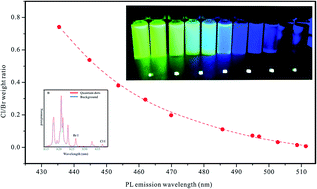Analysis of halide composition in CsPb(Br/Cl)3 nanocrystals with trace amounts of samples using laser induced breakdown spectroscopy
Abstract
It is essential to determine the elemental composition of doped functional materials, particularly for nanometer scale semiconductors, to guide synthesis and interpret physical phenomena. This study applied laser induced breakdown spectroscopy (LIBS) for elemental analysis of halides in perovskite type quantum dots, i.e., CsPbX3 nanocrystals (NCs). The optimum LIBS delay time and laser energy were experimentally determined, and small quantities of CsPbX3 NCs (μg) with different Cl/Br ratios and different photoluminescence (PL) properties were measured. Coefficients to correlate weight and LIBS emission intensity ratios for Cl and Br were experimentally determined from CuBr2/CaCl2 mixtures. The measured Cl/Br weight ratios correspond to NC PL emission wavelengths and the supplied amount of PbCl2 precursor. The proposed LIBS approach showed better sensitivity and stability than electron dispersive spectroscopy. Ideal detection accuracy and precision could be realized using LIBS, requiring only trace amounts of NC samples and simple pretreatment processes, with NC integrity retained until the test.



 Please wait while we load your content...
Please wait while we load your content...